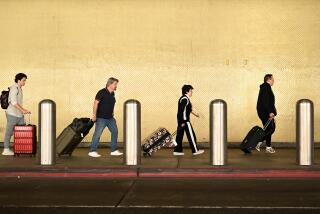Traveling Light Like Never Before
- Share via
The bag was clearly a no-go. I knew it the minute I saw it sitting, overstuffed and cozy, at its owner’s feet in the filled-to-the-gills gate area. I was sure the attendants would not allow it on the plane.
I was wrong.
Not only did it make it onto the plane (which was already two hours late on this Sunday after Thanksgiving), but the owner also tried to stuff its bulk into an overhead compartment, its mass making “under the seat in front of you” an impossible dream. As he scrambled to cram the bag in, he managed to hold up the line of passengers eager to take their seats, further delaying the flight.
With the new realities of air travel this holiday season, it’s unlikely such a passenger will get as far this year, but that doesn’t mean that some--who haven’t flown since Sept. 11 and are unfamiliar with new restrictions--won’t try.
Holiday travelers this year need to be prepared for added scrutiny and strict adherence to rules and laws as never before. What may have flown in previous years may not fly this season. After Sept. 11, the Federal Aviation Administration issued strict new guidelines for what is allowed and what is forbidden in the aircraft cabin.
One carry-on bag plus a purse, day pack or briefcase is allowed per person. Period.
“They will not let you bring anything else this year,” says Melissa Klurman, a packing expert and an editor at Fodor’s Travel Publications. “So save yourself some trouble.”
Furthermore, the size of carry-on bags is limited. Though each airline has its own restrictions, you’ll be generally safe with a bag that measures less than 9 by 14 by 22 inches and weighs less than 40 pounds. (Check with your airline if you have questions.) And that does not mean you can stuff a bag that size to bulging and expect it to fly--in the cabin, at least. Those are the outer dimensions of a fully packed carry-on bag.
Besides size, there’s the question of content. Here’s what you may not take in your carry-on, according to the FAA:
* Knives of any length, composition or description
* Cutting instruments of any kind and composition, including carpet knives and box cutters (and spare blades), any device with a folding or retractable blade, ice picks, straight razors, metal scissors and metal nail files.
* Corkscrews
* Baseball or softball bats
* Golf clubs
* Pool cues
* Ski poles
* Hockey sticks
Items permitted by the FAA:
* Pets (but check with your airline for procedures)
* Walking canes and umbrellas (once they’ve been inspected to ensure prohibited items are not concealed)
* Nail clippers
* Safety razors (including disposable razors)
* Syringes (with medication and professionally printed label identifying medication or manufacturer’s name)
* Tweezers
* Eyelash curlers
If in doubt, the FAA recommends you place the item in your checked bags. Be prepared for random searches of your belongings (and yourself) before boarding.
At Christmastime, wrapped packages that might have sailed through in past years may be more likely to be unwrapped and searched this year.
Klurman suggests you check wrapped items or wrap them at your destination. Or you could save yourself some trouble by shipping them or buying and wrapping them there. (“Nobody ever says, ‘Gee, I wish my bags were heavier,”’ Klurman says.)
So we know what you cannot take on board, but what should you include in a carry-on bag? You may modify this list to suit your needs and destination, but here are some essentials: medicine (clearly labeled in the original bottle); a sweater and maybe a clean shirt or blouse and underwear (in case you are delayed or lose your checked bags); a small toiletries kit; travel documents (tickets, hotel and car reservation confirmations, itineraries); maps or guidebooks; reading material; bottled water; eyeglasses; tissues; writing materials; and lip balm and sunscreen.
If you are absolutely set on not checking your bags, there are ways you can make the most of the limited space of a carry-on. Your bag should be no heavier than what you can comfortably hoist; experts recommend 25 pounds or less. If you can’t lift it, lighten it.
Packing pros recommend something they call the “bundle” or “interlock.” This means you essentially build the clothing into a bundle that allows you to maximize the space in your bag and minimize wrinkles. Start with the largest item of clothing--a dress or sport jacket--draping it over the bottom of your open suitcase. Then layer your other clothing on top of it, alternately placing the clothes lengthwise and crosswise on the bottom piece. When finished with the large clothes, place the “core pouch”--a small, flat, square bag containing your underwear, socks, swimwear etc.--in the middle of your clothing bundle and fold sleeves, skirts etc. around it. Toiletries go in outside pockets.
But remember, don’t overstuff. Less is more: more efficient, more courteous and more manageable. And in this environment, managing your travel is important to ensure happy holidays.
Packing Tips Here are some ideas from the experts to help you pack more mileage into less clothing:
Weed out the excess. Start by laying out all your clothes 24 hours ahead of time. Then reassess whether you really need two sweaters and five pairs of shoes, or whether you could do just as well with one sweater and one pair of shoes.
Wear your heaviest or bulkiest clothes and shoes on the plane. Don’t pack a jacket; wear it or carry it over your arm. (It does not count against your carry-on limit.)
Pack two sets of underwear and socks, especially if you have access to a washer and dryer (or take along a travel-size bottle of detergent and do your laundry in the sink). Even better, take old clothes and give or throw them away as you go, lightening your load for the trip home and freeing up room for items acquired on the trip.
Leave the blow dryer and curling iron at home. Borrow from family or, if you are staying in a hotel, check to see whether a blow dryer is among the amenities. Likewise heavy bottles of shampoo and other liquids.
Coordinate your wardrobe around just two or three colors. This increases your outfit choices because everything goes with everything else.
Accessorize. Use scarves, ties and different shirts or blouses to vary your wardrobe. For men, a dark blue suit is one of the most practical outfits: It’s a suit today, a blue blazer with khaki slacks tomorrow, and blue slacks with a dress or polo shirt for less formal occasions. For women, basic black can be dressed up or down and covers a multitude of occasions.
*
James Gilden, a frequent traveler and master packer, lives in Los Angeles.
More to Read
Sign up for The Wild
We’ll help you find the best places to hike, bike and run, as well as the perfect silent spots for meditation and yoga.
You may occasionally receive promotional content from the Los Angeles Times.






